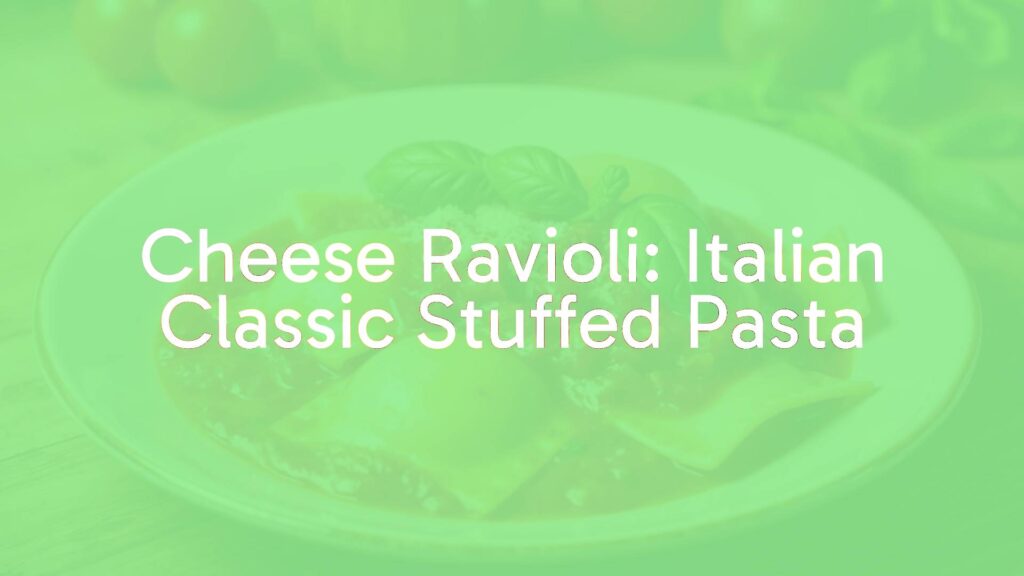Understanding Cheese Ravioli
Cheese ravioli stands as a beloved staple of Italian cuisine, recognized for its comforting flavor and satisfying texture. Composed of delicate pasta envelopes encasing a rich, creamy cheese filling, cheese ravioli embodies the Italian tradition of transforming simple ingredients into elegant fare. This dish is appreciated for its versatility and ability to be enjoyed with a variety of sauces, making it a perennial favorite at family tables and formal occasions alike.
Origins and Cultural Significance
Ravioli itself has a long history in Italian gastronomy, with references dating back to the Middle Ages. Though the precise origins are debated, cheese ravioli has become particularly associated with the northern and central regions of Italy, such as Emilia-Romagna and Tuscany, where high-quality fresh cheese and egg pasta are produced. Traditionally prepared during holidays or festive gatherings, ravioli has often been used as a way to showcase regional cheeses and artisanal pasta-making techniques. The dish encapsulates the Italian appreciation for thoughtful food preparation and communal dining.
Distinctive Qualities
The hallmark of cheese ravioli lies in its balance between tender pasta and a luscious, savory filling. The pasta is typically made from durum wheat semolina or all-purpose flour, combined with eggs to create a supple yet sturdy dough. This dough is rolled thin, cut into squares or circles, and paired to enclose the cheese mixture. The uncooked ravioli are recognizable by their plump profile and neatly crimped or sealed edges, often featuring attractive fluted patterns.
The cheese filling itself is usually creamy and mild, providing a pleasing contrast to the gentle bite of the pasta. The finished ravioli, when cooked, offers a tender texture that yields to a rich, melting center, with subtle hints of nutty and tangy flavors from the cheese blend.
Essential Ingredients
The key to authentic cheese ravioli lies in quality ingredients. Typical fillings feature a mixture of ricotta cheese—valued for its smoothness and gentle sweetness—alongside sharper cheeses such as Parmigiano-Reggiano or Grana Padano. Some regional recipes include additions like mascarpone, mozzarella, or pecorino, introducing deeper flavor notes and differing textures. The filling is commonly seasoned with a hint of nutmeg, salt, pepper, and sometimes finely chopped herbs such as parsley or basil.
The pasta used in ravioli is traditionally made fresh, lending a tender, slightly elastic bite that distinguishes homemade varieties from pre-packaged options.
Variations and Adaptations
While classic cheese ravioli is filled with a mix of Italian cheeses, many variations exist to suit local tastes and ingredient availability. Some versions may blend in spinach or other greens for added color and nutrients, resulting in spinach and cheese ravioli. Others adapt fillings to include different regional cheeses or incorporate mushrooms, truffles, or delicate vegetables. For those seeking lactose-free or vegan options, plant-based ricotta alternatives and egg-free pasta dough offer approachable substitutions without sacrificing traditional appeal.
Serving Suggestions and Pairings
Cheese ravioli is remarkably versatile when it comes to accompaniments. In the simplest preparations, a drizzle of browned butter and crisp sage leaves heightens the cheese’s flavors. Tomato-based sauces, from light pomodoro to robust marinara, are classic pairings that add tang and acidity, offsetting the creamy filling. Richer covers such as Alfredo or a mushroom cream sauce are also popular, particularly in colder months.
As a main course, cheese ravioli pairs naturally with crisp green salads and roasted vegetables. Italian white wines like Pinot Grigio or a young Verdicchio highlight the freshness of the cheese, while a light red such as Chianti complements tomato sauces. For a festive occasion, sparkling Prosecco provides a refreshing counterpoint to the dish’s richness.
Conclusion
Cheese ravioli epitomizes the Italian culinary ethos—celebrating local ingredients, regional traditions, and the communal pleasure of shared meals. Whether prepared for a special gathering or enjoyed as an everyday comfort, it remains a testament to the timeless appeal of stuffed pasta in Italy’s vibrant food culture.

